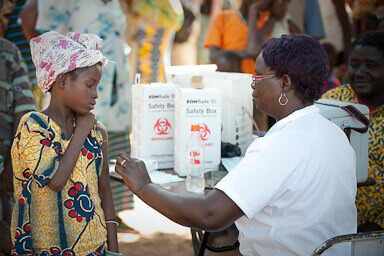Wednesday, the White House released President Obama’s fiscal year (FY) 2014 budget request,
which overall has mixed results for global health and research programs. Below, we provide specific details on funding levels at key agencies that
support global health and research efforts, including the Centers for Disease Control and Prevention (CDC),the US Food and Drug Administration (FDA), the National Institutes of Health (NIH), and the US Agency for International Development (USAID). Details are still forthcoming about how global health research fared at the Department of Defense. It’s important to note that figures are
compared to final FY2012 levels, since Congress is still working on finalizing FY2013 levels.

- The president's budget for FY2014 requests funding for key US agencies engaged in global health product development. Credit: PATH.
CDC
- CDC’s overall budget took a hit in the president’s request—the president’s FY2014 budget requested $5.2 billion for the agency overall, compared
with $5.65 billion in FY2012.
- However, CDC’s global health programs were slightly increased and were spared major cuts. CDC’s Center for Global Health would receive $393 million
in FY2014 under the president’s budget, compared with $376.7 million in FY2012.
FDA
- The FDA got a much-needed increase in the president’s budget request, although much of it is due to an expected uptick in user-fee income. The agency
would receive $4.65 billion in FY2014 under the president’s budget, compared with $3.83 billion in FY2012.
- As noted above, user-fee income plays a large part in this increase in FDA’s budget. User fees would comprise $2.09 billion of the agency’s budget
under the president’s request, compared with $1.32 billion in user fees in FY2012. In recent years, Congress has not adequately appropriated stable
funding to FDA, instead relying on user fees to make up the difference. Critics have said that relying on user fees is unsustainable and creates
a conflict of interest between FDA and the industries it regulates.
NIH
- NIH funding was mostly flat-lined at FY2012 levels—the president’s budget requested $31.3 billion for the NIH in FY2014, compared with $30.8
billion that the agency received in FY2012.
- The National Institute of Allergy and Infectious Diseases (NIAID), as well as the National Center for Advancing Translational Science (NCATS), received
increases that could hint at new programming in those areas. The president requested $4.6 billion for NIAID in FY2014, compared with $4.5 billion
the center received in FY2012. NCATS would receive $666 million under the president’s FY2014 budget, compared with $574 million in FY2012.
State Department and USAID
- At USAID, several key programs that fund global health research were cut dramatically—most notably the agency’s tuberculosis (TB) program. Most
other programs at USAID were flat-funded or saw small increases. Under the president’s budget, USAID’s global health programs would receive $2.645
billion in FY2014, which is pretty much the same figure ($2.649 billion) for FY2012.
- Under USAID’s global health programs, several key initiatives saw disappointing funding cuts. The TB program would be reduced to $191 million in FY2014,
compared with $236 million in FY2012. The HIV and AIDS program would be cut to $330 million, compared with $350 million in FY2012. The neglected tropical
diseases program would be cut to $85 million in FY2014, compared with $89 million in FY2012. Fortunately, the malaria program would see an increase
to $670 million in FY2014, compared with $650 million in FY2012.
- The State Department budget element getting the most buzz is the 5.3 percent cut to the President’s Emergency Plan for AIDS Relief, while the Global Fund to Fight AIDS, TB, and Malaria saw a robust request
of $1.65 billion for FY2014.
Federal agencies have also released their budget justifications, which detail policy and programmatic priorities for FY2014. We’ll provide a comprehensive
update on these budget justifications and key policies that could impact global health research and product development.
Usually, the President’s budget request sets a precedent that the advocacy community and Congress respond to—whether they agree or disagree with
its content. However, with the request being released so late in the year, Congress has already acted, passing drastically different FY2014 budget
resolutions in the House and Senate. House and Senate budget committee activity is moving quickly, with key leaders from US agencies that fund global
health research and product development scheduled to testify at appropriations hearings as early as next week. Congress must act to avoid further cuts
and fund global health research programs at the robust levels that ensure availability of new technologies to the millions who need them worldwide.
